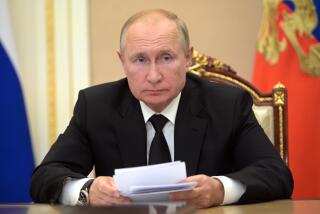Market Newsletter : U.S. Sales to Western Europe Are Soaring : Exports are keeping the American economy in control. And the EC has become our top customer.
- Share via
BRUSSELS — It is one of the largely unheralded economic phenomena of the 1990s: Exports are keeping the wobbly U.S. economy from spinning wildly out of control.
Economic output in the United States fell 0.7% last year. Exports, meanwhile, surged by almost 7%. Without that growth in exports, the year’s overall decline in output would have been double what it was.
Nowhere are U.S. exporters having better luck than in Europe. Sales to the 12 nations of the European Community soared by 8.5% in the first seven months of last year, to an annual level of $105 billion. That makes the EC the biggest foreign customer of American business, ahead of Canada ($85 billion) and Japan ($49 billion).
Consequently, the United States is running a hefty trade surplus with the EC--$16 billion at an annual rate through the first seven months of last year, compared with a deficit of nearly $20 billion just three years earlier.
Aircraft and electronics top the list of the U.S. industries with the strongest export growth.
“High-technology exports have led the way,” says Stephen Cooney, director of international investment and finance for the National Assn. of Manufacturers in Washington. “The cliche that the United States is exporting potato chips, not semiconductor chips, is not accurate.”
The question is: Can it continue?
Some of the major causes of U.S. exporters’ success here--a weak dollar and strong European economic growth--are transitory. Yet the export surge is persisting, and the NAM’s Cooney, for one, believes it can continue if American companies keep their eye on overseas markets.
The export boom began when the dollar, which relentlessly gained in value during the first half of the 1980s, began sliding back down in early 1985. Since then, the dollar has lost nearly half its value against many Western European currencies. A U.S.-made widget whose price in dollars has not changed costs barely more now than half as many German marks or French francs as it did in 1985.
That’s great for U.S. companies selling widgets in Europe. But European industry thinks it’s unfair.
And the German government, for one, agrees with its manufacturers. Germany has paid more than $200 million in “exchange-rate subsidies” to Daimler-Benz, one of the European manufacturers of the Airbus, to compensate for the competitive advantage it lost in its cutthroat competition with Boeing and other U.S. aircraft makers.
The United States protested to the General Agreement on Tariffs and Trade, the Geneva-based organization that polices international trade practices. A GATT panel recently held that the subsidies were illegal; its recommendation must still be confirmed by GATT’s subsidies committee before Germany will have to scrap its exchange-rate supports.
There are more potential problems.
Beyond the declining dollar, the climate in Europe has been right for U.S. goods. “EC ‘92”--the European Community’s program of dismantling barriers to trade among its 12 member nations by the end of 1992--is making it easier for U.S. as well as European manufacturers to operate here. And thanks to an economic boom in the second half of the 1980s, Western Europeans have had the wherewithal to buy foreign goods.
Now, however, Europe’s major economies are sagging. Britain remains stuck in recession, and Germany is teetering after its post-unification boom.
For this year, DRI-McGraw Hill, a U.S.-based forecasting firm, predicts weak economic growth of between 1% and 2% for Europe’s biggest economies--Britain, Germany, France and Italy.
For U.S. exporters, however, prospects may not be so bleak as those numbers suggest.
DRI predicts that merchandise imports will grow by a brisk 5% this year in Britain, Germany and France.
And those numbers miss the new sales opportunities that some American exporters are finding in Eastern Europe, particularly in eastern Germany.
Take Caterpillar Inc., for example, which had a poor year in 1991. With the U.S. economy mired in recession, the Illinois company could scarcely move its earth-moving machines off its U.S. showroom floors. Its bottom line showed $404 million in losses.
But Caterpillar salesman Wols Mocikat isn’t complaining. That’s because Mocikat is selling Caterpillar machines not in the flabby U.S. market but in eastern Germany, where business is booming.
“The demand is very great because the need in our region for roads, railroad tracks and sewage canals is enormous,” says Mocikat, Caterpillar’s branch manager in Berlin and regional manager for much of eastern Germany.
Caterpillar now has 14 outlets in the former East Germany, where there had been none until last February. Sales of its gigantic earthmovers jumped from none in 1989 to 355 in 1990 and 758 last year.
Altogether, half of Caterpillar’s sales last year were abroad; exports brought in $3.71 billion in revenue and supported 19,500 jobs in the United States.
The Multiplex Co. of St. Louis, which makes soft-drink dispensing machines for McDonalds and other restaurants, is finding its biggest growth markets in eastern Germany, Poland, Czechoslovakia, Hungary and even what used to be Yugoslavia.
“Yugoslavia has become our biggest Eastern European market,” says Robert Gehl, Multiplex’s German-based European general manager, with a note of surprise. “We managed to complete some deals there and even to get paid.”
U.S. companies that want to sell in Europe, Gehl advises, must be prepared to commit substantial resources--Multiplex established its German subsidiary in 1978--and to stick with that commitment for the long term.
“Companies taking a toe-in-the-water approach stand, at the very best, to get out what they put in,” he says. Last year was Multiplex’s best year ever in Europe, Gehl says, even though Western European business has leveled off as economies have slowed.
In Multiplex’s St. Louis headquarters, the company’s chairman, J. W. Kisling, says international sales have tripled in five years. About 35% of Multiplex’s revenue now comes from abroad, and 40% of that comes from Europe.
But Kisling sees a yellow flag in Europe: the drive to adopt uniform product standards across the 12 EC countries so that manufacturers that sell a product in one country can sell the same item in the other 11, without expensive modifications.
That sounds good in theory, Kisling says. But in practice, he worries that standards will be tailored to the products of European manufacturers, to the detriment of their foreign competitors.
“There is still an awful lot that’s uncertain,” Kisling says.
No U.S. industry has contributed as much to the European export boom as aircraft.
According to the Commerce Department, exports to Europe soared from about $4 billion in 1986 to $11.5 billion in 1990.
At the beginning of the 1980s, Cooney says, the U.S. civilian aircraft industry exported about one-quarter of its output. By the end of the decade, he says, the industry sold abroad an astonishing five-sixths of what it produced.
Boeing, which dominates the U.S. industry, is thriving on orders it received during the global boom years in the second half of the 1980s. It delivered 435 planes worldwide in 1991, up from 284 just two years earlier. Of those totals, 67% were sold outside the United States in 1991, compared with 60% in 1989.
Orders have begun to sag, however, from a peak of 883 planes in 1989 to 257 last year. The decline reflects not only the recession in the United States but also the softening economy in Europe.
When U.S. exports began rolling, U.S. manufacturers in the highly competitive electronics industry caught the wave. Now they may be among the first to feel the riptide of the slowing European economy.
Typical of the U.S. electronics industry, Hewlett-Packard has grown faster in Europe than in its home market for the past half-decade or so. Europe generated 27% of HP’s sales revenue in 1984 and 37% in 1991, according to Roger Wilson, HP’s public affairs director in Europe.
Robert P. Wayman, Hewlett-Packard’s chief financial officer in Palo Alto, attributes the initial burst of sales in Europe in the mid-1980s to the falling dollar. For the past year or two, however, HP’s sales in Europe have grown smartly even though the dollar’s value has changed little against most European currencies.
“We have had a very strong product line playing into a relatively strong economy,” Wayman says. Sales of computer peripherals--especially laser printers--and work-station computers have been particularly solid.
For HP, there are signs of trouble ahead. In 1991, for the first time in six years, the company reported no growth in international orders (Europe, Asia and elsewhere). Revenue from abroad may follow suit. “We are anticipating continued moderate growth in Europe,” Wayman says cautiously.
More to Read
Inside the business of entertainment
The Wide Shot brings you news, analysis and insights on everything from streaming wars to production — and what it all means for the future.
You may occasionally receive promotional content from the Los Angeles Times.










